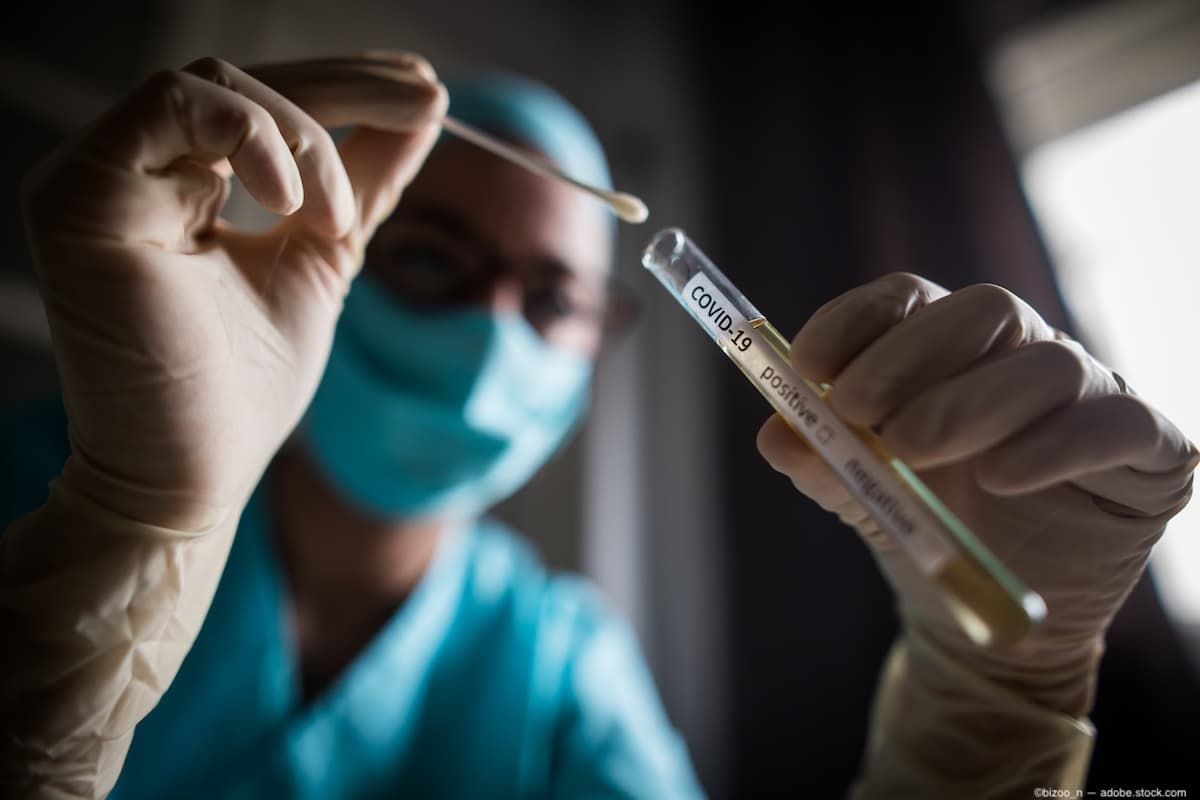Neuro-ophthalmic adverse events associated with COVID-19 infection and vaccinations
Researchers conducted a large nationwide, population-based, retrospective cohort study to determine if there is an association between COVID-19 infection and vaccination with neuro-ophthalmic adverse events.
Image credit: ©bizoo_n – stock.adobe.com

Korean researchers reported that ptosis was associated with COVID-19 vaccination, particularly with the ChAdOx1 vaccine (AstraZeneca), while Guillain-Barré syndrome/Miller Fisher syndrome was associated with the COVID-19 infection,1 according to first authors Jae Yong Han, MD, and Sunyeup Kim, MD, from, respectively, the Department of Ophthalmology, Institute of Vision Research, Yonsei University College of Medicine, Seoul, Republic of Korea, and the Department of Medical AI, Sungkyunkwan University School of Medicine, Suwon, Republic of Korea.
With the numbers of infected individuals and vaccine recipients are rising, a growing number of ocular adverse events, including neuro-ophthalmic adverse events, have been reported in individuals with the COVID-19 infection and vaccinated individuals.2-6 Other studies reported that COVID-19 was associated with optic neuritis7-9 and ophthalmoplegia was related to third or sixth cranial nerve palsy.10-16 Adverse events caused by the vaccine have been reported.17–21 However, the investigators explained, it is unclear if COVID-19 infection and vaccination are related directly to neuro-ophthalmic adverse events.
They conducted a large nationwide, population-based, retrospective cohort study to determine if there is an association between COVID-19 infection and vaccination with neuro-ophthalmic adverse events.
About 8.5 million patients in the Korean National Health Claim Database were classified in 1 of 3 groups: controls, those with the COVID-19 infection, and those vaccinated against COVID-19. The researchers separately analyzed the early phase (within 60 days) and late phases (61–180 days) to estimate the incidence rates and hazard ratio (HR) for each neuro-ophthalmic adverse event that included optic neuritis, papilledema, ischemic optic neuropathy, third nerve palsy, fourth nerve palsy, sixth nerve palsy, facial palsy, nystagmus, ptosis, blepharospasm, anomalies of pupillary function, and Guillain-Barré syndrome/Miller Fisher syndrome.
Associations found
The authors reported that neuro-ophthalmic adverse events, except for ptosis and Guillain-Barré syndrome/Miller Fisher syndrome, showed no significant increase after COVID-19, and their incidence rates were extremely low. The incidence rates of ptosis in the early and late phases were significantly higher in patients who received the COVID-19 vaccination (HR = 1.65 in the early phase and 2.02 in the late phase) compared with the control group. The BNT162b2 (Pfizer–BioNTech) vaccine was associated with a lower ptosis risk than the ChAdOx1 vaccine. Guillain-Barré syndrome/Miller Fisher syndrome occurred significantly more often during the early phase (HR = 5.97) in patients with COVID-19 infection than in the control group.
The authors concluded, “Ptosis was associated with the COVID-19 vaccination, particularly with the ChAdOx1 vaccine, while Guillain-Barré syndrome/Miller Fisher syndrome was associated with the COVID-19 infection. In contrast, no association was found between other neuro-ophthalmic adverse events and COVID-19 infection or vaccination. These results may provide helpful insights for diagnosing and treating neuro-ophthalmologic adverse events after COVID-19.”
References
Han JY, Kim S, Han I, et al. Neuro-ophthalmic adverse events of COVID-19 infection and vaccines: a nationwide cohort study. Invest Ophthalmol Vis Sci. 2023;64:37; doi:https://doi.org/10.1167/iovs.64.14.37
Dockery DM, Rowe SG, Murphy MA, Krzystolik MG. The ocular manifestations and transmission of COVID-19: recommendations for prevention. J Emerg Med. 2020;59:137–140.
Douglas KA, Douglas VP, Moschos MM. Ocular manifestations of COVID-19 (SARS-CoV-2): a critical review of current literature. In Vivo. 2020;34(3 suppl):1619–1628.
Eleiwa T, Abdelrahman SN, ElSheikh RH, Elhusseiny AM. Orbital inflammatory disease associated with COVID-19 infection. J AAPOS. 2021;25:232–234.
Ho D, Low R, Tong L, Gupta V, Veeraraghavan A, Agrawal R. COVID-19 and the ocular surface: a review of transmission and manifestations. Ocul Immunol Inflamm. 2020;28:726–734.
Wang D, Hu B, Hu C, et al. Clinical characteristics of 138 hospitalized patients with 2019 novel coronavirus–infected pneumonia in Wuhan, China. JAMA. 2020;323:1061–1069.
Benito-Pascual B, Gegúndez JA, Díaz-Valle D, et al. Panuveitis and optic neuritis as a possible initial presentation of the novel coronavirus disease 2019 (COVID-19). Ocul Immunol Inflamm. 2020;28:922–925.
Parvez Y, AlZarooni F, Khan F. Optic neuritis in a child with COVID-19: a rare association. Cureus. 2021;13.
Sawalha K, Adeodokun S, Kamoga G-R. COVID-19-induced acute bilateral optic neuritis. High Impact Case Rep. 2020;8:2324709620976018.
de Oliveira MR, Lucena ARV, Higino TM, Ventura CV. Oculomotor nerve palsy in an asymptomatic child with COVID-19. J AAPOS. 2021;25:169–170.
Dinkin M, Gao V, Kahan J, et al. COVID-19 presenting with ophthalmoparesis from cranial nerve palsy. Neurology. 2020;95:221-223; doi: 10.1212/WNL.0000000000009700.
Falcone MM, Rong AJ, Salazar H, et al. Acute abducens nerve palsy in a patient with the novel coronavirus disease (COVID-19). J AAPOS. 2020; 24(4): 216–217.
Francis JE. Abducens palsy and anosmia associated with COVID-19: a case report. BIOJ. 2021;17:8.
Gold DM, Galetta SL. Neuro-ophthalmologic complications of coronavirus disease 2019 (COVID-19). Neurosci Lett. 2021;742:135531.
Lonardi V, Meneghesso D, Debertolis G, et al. Isolated third cranial nerve palsy and COVID-19 infection in a child. Pediatr Neurol. 2021;120:11.
Sriwastava S, Tandon M, Kataria S, Daimee M, Sultan S. New onset of ocular myasthenia gravis in a patient with COVID-19: a novel case report and literature review. J Neurol. 2021;268:2690–2696.
Eleiwa TK, Gaier ED, Haseeb A, et al. Adverse ocular events following COVID-19 vaccination. J Inflamm. 2021;70:1005–1009.
Kang K, Lee SY, Lee DC. Neuro-ophthalmologic symptoms after coronavirus disease 2019 vaccination: a retrospective study. BMC Ophthalmol. 2023;23:1–12.
Manea MM, Dragoș D, Enache I, Sirbu AG, Tuta S. Multiple cranial nerve palsies following COVID-19 vaccination—case report. Acta Neurol Scand. 2022;145:257–259.
Pappaterra MC, Rivera EJ, Oliver AL. Transient oculomotor palsy following the administration of the messenger RNA-1273 vaccine for SARS-CoV-2 diplopia following the COVID-19 vaccine. J Neuroophthalmol. 2023;43:e14-e15; doi: 10.1097/WNO.0000000000001369.
Reyes-Capo DP, Stevens SM, Cavuoto KM. Acute abducens nerve palsy following COVID-19 vaccination. J AAPOS. 2021;25:302–303.
Newsletter
Keep your retina practice on the forefront—subscribe for expert analysis and emerging trends in retinal disease management.